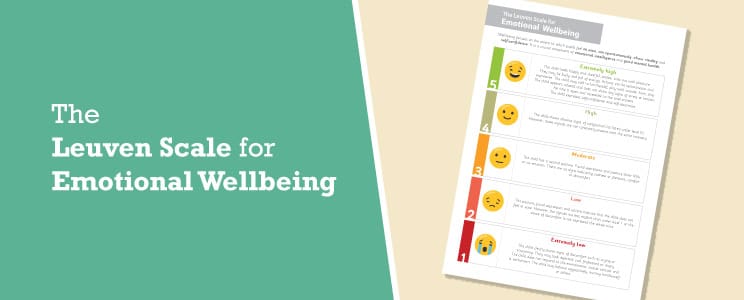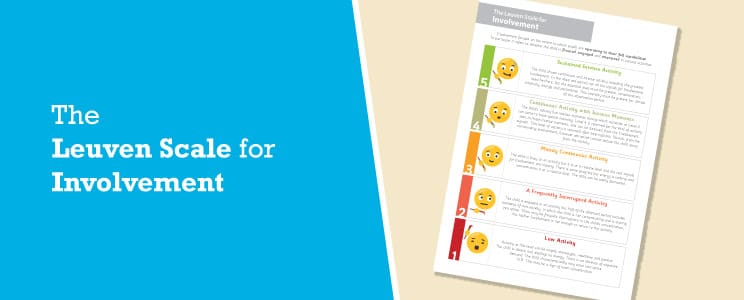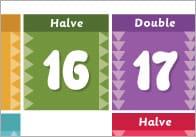Ferre Laevers emotional well being and involvement scales (Leuven Scale)

Following on from my post about planning your learning environment I thought I’d write a little bit about the Leuven scales for emotional well being and involvement (developed by the Research Centre for Experiential Education at Leuven University, under the supervision of Professor Ferre Laevers). These are two sets of indictors that should be considered when planning any educational setting (they are not designed solely for early childhood education but are equally applicable in primary, secondary, higher and adult education).
Emotional well being
Well-being focuses on the extent to which pupils feel at ease, act spontaneously, show vitality and self-confidence. It is a crucial component of emotional intelligence and good mental health.
The Leuven Scale for Well-being
1) Extremely low
The child clearly shows signs of discomfort such as crying or screaming. They may look dejected, sad, frightened or angry. The child does not respond to the environment, avoids contact and is withdrawn. The child may behave aggressively, hurting him/herself or others.
2) Low
The posture, facial expression and actions indicate that the child does not feel at ease. However, the signals are less explicit than under level 1 or the sense of discomfort is not expressed the whole time.
3) Moderate
The child has a neutral posture. Facial expression and posture show little or no emotion. There are no signs indicating sadness or pleasure, comfort or discomfort.
4) High
The child shows obvious signs of satisfaction (as listed under level 5). However, these signals are not constantly present with the same intensity.
5) Extremely high
The child looks happy and cheerful, smiles, cries out with pleasure. They may be lively and full of energy. Actions can be spontaneous and expressive. The child may talk to him/herself, play with sounds, hum, sing. The child appears relaxed and does not show any signs of stress or tension. He /she is open and accessible to the environment. The child expresses self-confidence and self-assurance.
The rationale underlying the focus on these two process dimension is that high levels of well-being and involvement lead in the end to high levels of child development and deep level learning. This latter concept is centred around the notion that learning should result in significant changes in a pupils capacity leading to better outcomes in the way that he or she approaches work, relationships and life in general.

View an illustrated poster of the Leuven scale for emotional wellbeing.
Level of involvement
Involvement focuses on the extent to which pupils are operating to their full capabilities. In particular it refers to whether the child is focused, engaged and interested in various activities.
The Leuven Scale for Involvement
1) Low Activity
Activity at this level can be simple, stereotypic, repetitive and passive. The child is absent and displays no energy. There is an absence of cognitive demand. The child characteristically may stare into space. N.B. This may be a sign of inner concentration.
2) A Frequently Interrupted Activity
The child is engaged in an activity but half of the observed period includes moments of non-activity, in which the child is not concentrating and is staring into space. There may be frequent interruptions in the child’s concentration, but his/her Involvement is not enough to return to the activity.
3) Mainly Continuous Activity
The child is busy at an activity but it is at a routine level and the real signals for Involvement are missing. There is some progress but energy is lacking and concentration is at a routine level. The child can be easily distracted.
4) Continuous Activity with Intense Moments
The child’s activity has intense moments during which activities at Level 3 can come to have special meaning. Level 4 is reserved for the kind of activity seen in those intense moments, and can be deduced from the ‘Involvement signals’. This level of activity is resumed after interruptions. Stimuli, from the surrounding environment, however attractive cannot seduce the child away from the activity.
5) Sustained Intense Activity
The child shows continuous and intense activity revealing the greatest Involvement. In the observed period not all the signals for Involvement need be there, but the essential ones must be present: concentration, creativity, energy and persistence. This intensity must be present for almost all the observation period.

View an illustrated poster of the Leuven scale for involvement.
Measuring well-being and involvement
The evaluation process begins by assessing the levels of well-being and involvement using the scales outlined above. Educators must observe pupils as a group or individually for a period of approximately two minutes then give a score for wellbeing and/or involvement. It is thought that unless pupils are operating at 4 or 5, learning will be limited. However, it is natural for levels of well-being and involvement to fluctuate throughout the day and it is therefore unrealistic to expect children to operate at levels 4 or 5 at all times.
The initial observation is the starting point for further analysis concentrating on pupils with lower levels of well-being and / or involvement. This analysis should inform educators about the quality and suitability of their work and it should provide some sort of framework for intervention toward individual pupils.
Measuring a child’s wellbeing and involvement can also empower and energise teachers and practitioners. If educators can see that their efforts are leading to a high level of wellbeing and involvement in their pupils then it’s likely that this will serve as a galvanising force and result in a cycle of continual improvement.
Ten action points
The Research Centre for Experiential Education (RCEE) has produced a list of 10 action points that should help practitioners to focus the learning environment on the well-being and involvement of pupils:
1. Rearrange the classroom in appealing corners or areas.
2. Check the content of the areas and make them more challenging.
3. Introduce new and unconventional materials and activities.
4. Identify children’s interests and offer activities that meet these.
5. Support activities by stimulating inputs.
6. Widen the possibilities for free initiative and support them with sound agreements.
7. Improve the quality of the relations amongst children and between children and teacher(s).
8. Introduce activities that help children to explore the world of behaviour, feelings and values.
9. Identify children with emotional problems and work out sustaining interventions.
10. Identify children with developmental needs and work out interventions that engender involvement.
In addition to the action points Professor Ferre Laevers (director of the RCEE) highlights the importance of the way in which adults interact with children. He believes that this is key to the achievement of well-being and involvement and recommends the use of the Adult Style Observation Schedule (ASOS), which is made up of three components: stimulation, sensitivity and giving autonomy. Writing in an article published in the Encyclopeida of Early Childhood Development, Dr. Laevers defined the three components in the following terms:
“Stimulating interventions are open impulses that engender involvement, such as: suggesting activities to children, inviting children to communicate, asking thought-provoking questions and giving rich information. Sensitivity is evidenced in responses that witness empathic understanding of the child. Giving autonomy means: respecting the children’s initiative, acknowledging their interests, giving them room for experimentation, letting them decide upon the way an activity is performed and letting them participate in the setting of rules”.
The work of Ferre Laevers and the RCEE is well known and much admired among early childhood educators. Nevertheless I hope that my brief outline of their approach to well-being and involvement will be of use and will encourage those educators less familiar with the Experiential Education approach to do their own research in to this methodology.
You can find out more about Ferre Laevers in this Nursery World Magazine article.This article was written by Katherine Lewis and published on 23/5/2011. It was updated in December 2020.
Comments
Leave a Reply
Popular Teaching Resources
Stay Up To Date
Sign up for our newsletter and we’ll let you know when we create new early years resources.






This information was so helpful and simple to undrestand, i found it so interesting and ture when understanding children
plc show or send emotional well being scale for 5th standard students
i found this extremely interesting. Is thier a versoin or proforma that i could use to assess younger children age range 3-5 years old.
I found this extremely helpful when looking for research for my BA (hons)in Educational Leadership Child centred module. It was an interesting read too and really related to the age group I work with which can sometimes be sparce when working with babies.
i was wandering how this would be shown in a realistic way in an assessment of a child with high level of complex needs
Really helpful for evaluating the value of my Forest School Programme. Thank you for making it so clear and ‘usable’.
Incredibly helpful and useful information. Thank you for sharing such an invaluable resource.
This is very helpful! How can i use this information, who can i refer to?
Very informative and useful? thanks very much
This is very handy doing my degree of childrens learning and development for both modules im currently doing which are play and pedagodgy and social&Emotional development
this is really helpful for my degree in early years. please could have the authors names and date this was written so I can reference this please
Hello. I found this really useful for some action research i am conducting about stimulating environments for children in reception. Please also can i have the date this was posted and any other reference information.thanks
I came across this during my PhD research and wanted to find evidence for its validity and reliability for non-verbal children – can you advise
Really useful for my essay could I have the date posted and anything else relevant to reference please?
Hi Louise, the author is Katherine Lewis and it was published on 23/05/2011
Easily understood and have found this an interesting read to update and refresh my personal learning for Education.